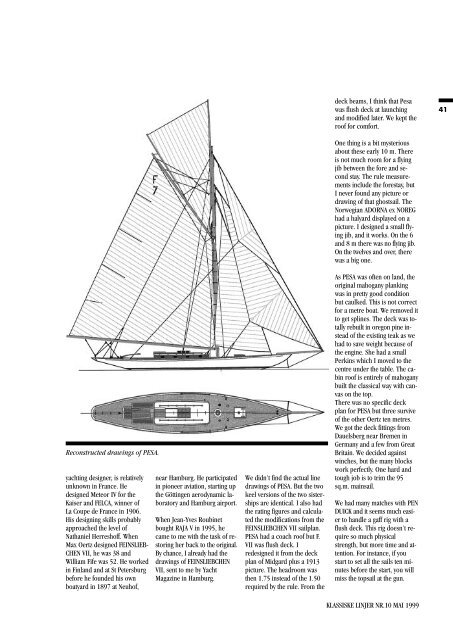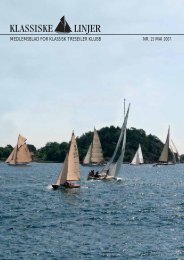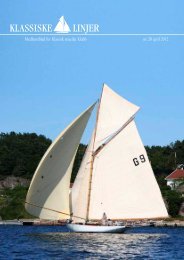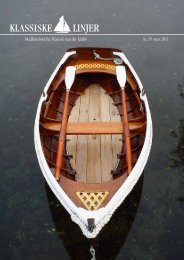Klassiske Linjer nr 10 1999 - Klassisk Treseiler Klubb
Klassiske Linjer nr 10 1999 - Klassisk Treseiler Klubb
Klassiske Linjer nr 10 1999 - Klassisk Treseiler Klubb
You also want an ePaper? Increase the reach of your titles
YUMPU automatically turns print PDFs into web optimized ePapers that Google loves.
Reconstructed drawings of PESA.<br />
yachting designer, is relatively<br />
unknown in France. He<br />
designed Meteor IV for the<br />
Kaiser and FELCA, winner of<br />
La Coupe de France in 1906.<br />
His designing skills probably<br />
approached the level of<br />
Nathaniel Herreshoff. When<br />
Max Oertz designed FEINSLIEB-<br />
CHEN VII, he was 38 and<br />
William Fife was 52. He worked<br />
in Finland and at St Petersburg<br />
before he founded his own<br />
boatyard in 1897 at Neuhof,<br />
near Hamburg. He participated<br />
in pioneer aviation, starting up<br />
the Göttingen aerodynamic laboratory<br />
and Hamburg airport.<br />
When Jean-Yves Roubinet<br />
bought RAJA V in 1995, he<br />
came to me with the task of restoring<br />
her back to the original.<br />
By chance, I already had the<br />
drawings of FEINSLIEBCHEN<br />
VII, sent to me by Yacht<br />
Magazine in Hamburg.<br />
We didn't find the actual line<br />
drawings of PESA. But the two<br />
keel versions of the two sisterships<br />
are identical. I also had<br />
the rating figures and calculated<br />
the modifications from the<br />
FEINSLIEBCHEN VII sailplan.<br />
PESA had a coach roof but F.<br />
VII was flush deck. I<br />
redesigned it from the deck<br />
plan of Midgard plus a 1913<br />
picture. The headroom was<br />
then 1.75 instead of the 1.50<br />
required by the rule. From the<br />
deck beams, I think that Pesa<br />
was flush deck at launching<br />
and modified later. We kept the<br />
roof for comfort.<br />
One thing is a bit mysterious<br />
about these early <strong>10</strong> m. There<br />
is not much room for a flying<br />
jib between the fore and second<br />
stay. The rule measurements<br />
include the forestay, but<br />
I never found any picture or<br />
drawing of that ghostsail. The<br />
Norwegian ADORNA ex NOREG<br />
had a halyard displayed on a<br />
picture. I designed a small flying<br />
jib, and it works. On the 6<br />
and 8 m there was no flying jib.<br />
On the twelves and over, there<br />
was a big one.<br />
As PESA was often on land, the<br />
original mahogany planking<br />
was in pretty good condition<br />
but caulked. This is not correct<br />
for a metre boat. We removed it<br />
to get splines. The deck was totally<br />
rebuilt in oregon pine instead<br />
of the existing teak as we<br />
had to save weight because of<br />
the engine. She had a small<br />
Perkins which I moved to the<br />
centre under the table. The cabin<br />
roof is entirely of mahogany<br />
built the classical way with canvas<br />
on the top.<br />
There was no specific deck<br />
plan for PESA but three survive<br />
of the other Oertz ten metres.<br />
We got the deck fittings from<br />
Dauelsberg near Bremen in<br />
Germany and a few from Great<br />
Britain. We decided against<br />
winches, but the many blocks<br />
work perfectly. One hard and<br />
tough job is to trim the 95<br />
sq.m. mainsail.<br />
We had many matches with PEN<br />
DUICK and it seems much easier<br />
to handle a gaff rig with a<br />
flush deck. This rig doesn't require<br />
so much physical<br />
strength, but more time and attention.<br />
For instance, if you<br />
start to set all the sails ten minutes<br />
before the start, you will<br />
miss the topsail at the gun.<br />
KLASSISKE LINJER NR.<strong>10</strong> MAI <strong>1999</strong><br />
41






